Bell has revealed a hybrid electric propulsion system utilizing six tilting ducted fans for its air taxi vehicle, which it has named the Bell Nexus.
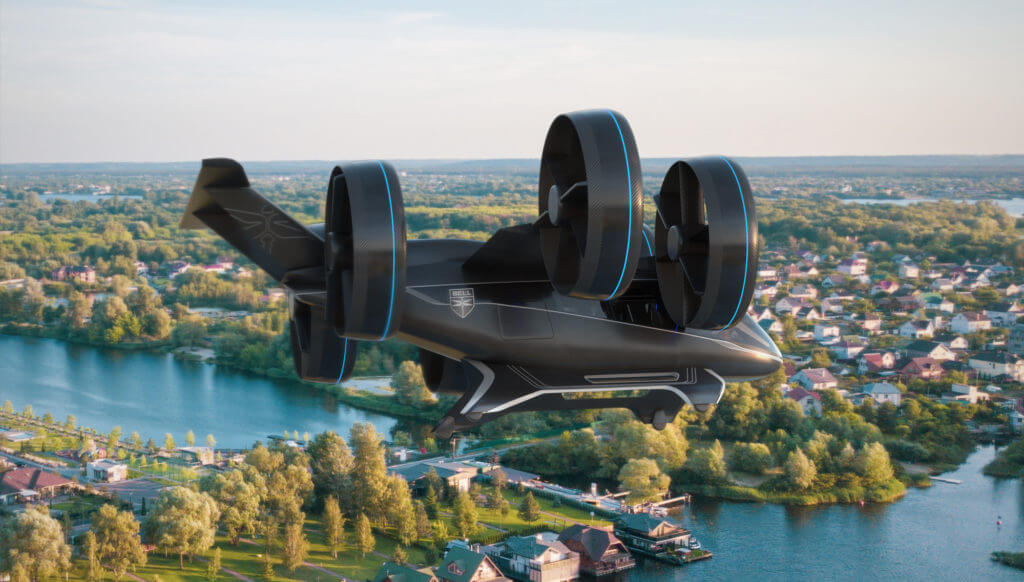
The Nexus has been unveiled in the form of a full-scale mockup at CES 2019 in Las Vegas, Nevada, where it has been joined at Bell’s booth by a “future flight controls” experience that the company has launched to help inform the design of the aircraft’s pilot interface.
Bell’s VP of innovation, Scott Drennan, said the development of the technologies behind the Nexus heralded “a new era of flight,” and believes viable commercial operations for the type will be possible in the mid-2020s. First flight of a fully-autonomous technology demonstrator is planned for the early 2020s.
“The concept of air taxi is really nothing new to us — we’ve been moving people over urban obstacles for a long time,” said Scott Drennan, VP of innovation at Bell. “What is new is the emergence and development of technologies that enable safe, quiet, efficient, and perhaps most importantly, affordable urban air mobility operations at scale, using small heavily automated electric and hybrid electric vertical lift aircraft.”
According to Bell, Nexus derives its name from sitting at the nexus of transport and technology, and of comfort and convenience. And while the Nexus is being developed in collaboration with Uber, but Drennan stressed that Bell is not building the aircraft solely for the ride-sharing technology company.
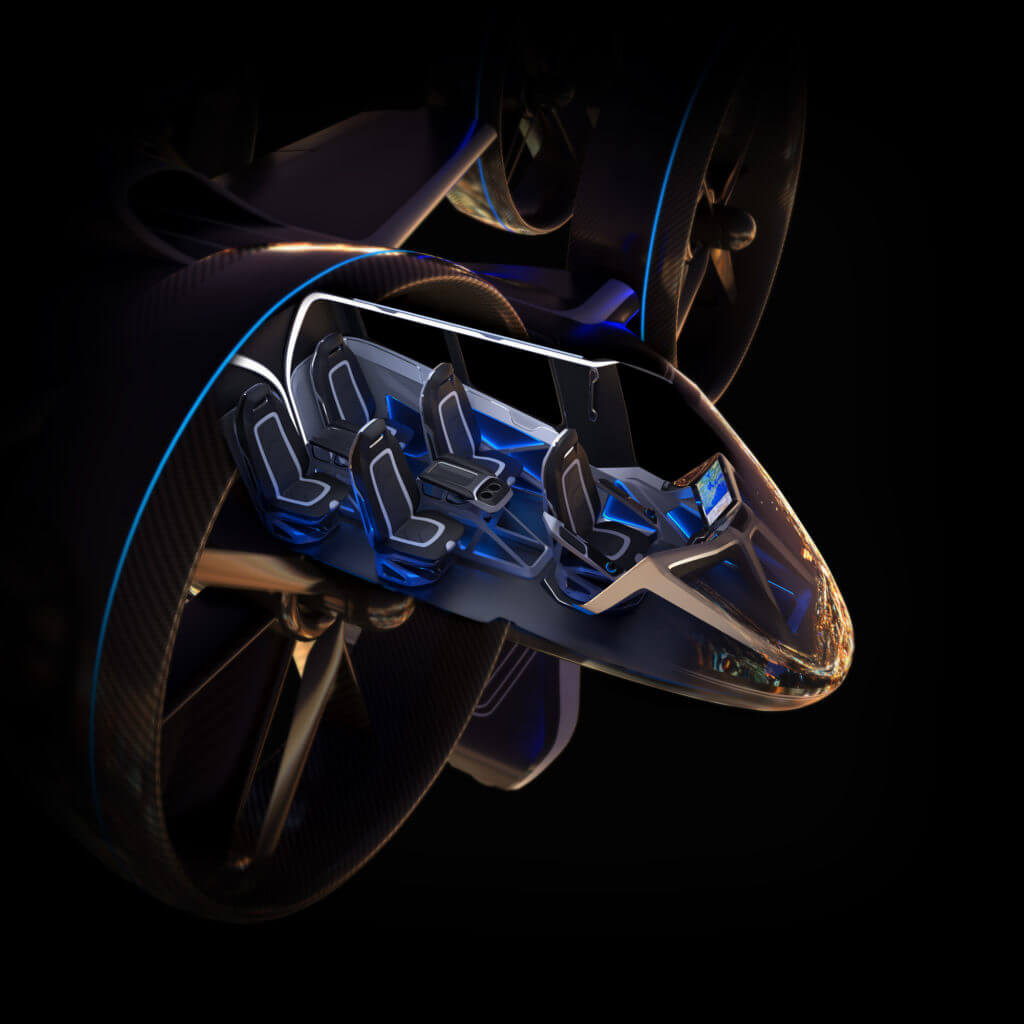
It’s the second year in a row that Bell has appeared at CES — a mecca for showcasing the latest technological developments and innovations from around the world — and follows the unveiling of the mockup of the Nexus’s fuselage at the event 12 months ago.
The event has been carefully chosen by Bell as the perfect testing ground for the technology, with its “early adopter” attendees exactly the type of people likely to be the first users of this type of new urban air mobility project. And, given the promise of air taxis to bring vertical lift transport to the masses, early feedback from those outside traditional aviation circles is crucial.
It was the desire to enhance the “approachability” of the aircraft that helped inform the choice of ducted fans for the Nexus, said Drennan.
“We believe that [people] coming up to an air vehicle like this for the first time will appreciate the covered nature or the introverted nature of our rotor blades here,” he said.
The aircraft has three four-bladed ducted fans, each spanning about eight feet in diameter, attached above door-level on each side of the fuselage. The front and rear ducts are close to the fuselage, while the middle ducts extend out at the end of short “wings,” giving the aircraft a disc-shaped footprint that’s very familiar to the vertical takeoff and landing (VTOL) community.
Three fans rotate clockwise and three counter clockwise to balance the torque the aircraft generates, and rpm control is separate to the engine, allowing it to continue running even when the blades are stopped. The blades in the fan will be able to start and stop extremely quickly, Bell said — which would prove extremely helpful in efficiently loading and unloading passengers.
The aircraft’s rotors and ducts not only provide its thrust, but also serve to control the aircraft’s pitch, roll and yaw.
In terms of the sheer size of the aircraft, the Nexus will fit in a 40-foot-by-40-foot box. “This is no toy,” said Drennan. “I think our serious competitors across the board will show vehicles of similar size.”
Bell believes this size of vehicle — with a gross weight of “about 6,000 pounds” and capable of carrying four passengers and a pilot — will hit the sweet spot of the potential air taxi market.
The aircraft’s ducts have a crucial part to play in terms of allowing it to achieve the performance it needs to carry such loads, enhancing the power produced by the Nexus’s hybrid electric propulsion system. (The ducts will also keep the noise the Nexus produces to a minimum — a crucial consideration for public acceptance of fleets of such aircraft in our urban skies.)
A New Approach to Propulsion
In the “series hybrid electric propulsion system” used in the Nexus, a turbine engine, similar to that used in a traditional helicopter, is used to turn an electric generator, producing DC electricity. That electricity is then distributed through a redundant power control system to the aircraft’s six fans.

Each fan has a direct drive electric motor, eliminating the need for a gearbox, and replacing the connecting shafts of a traditional helicopter with wires.
The Nexus also has a high-powered battery that provides extra power to the aircraft when it needs it (such as during takeoff or to hover), and serves as a redundant power source for the overall system if the engine fails, allowing the aircraft to land safely under its own power.
This is a key safety feature for the aircraft, said Drennan.
“You’ll see some of our competitors out there using parachutes and so forth [in the event of an engine failure], and Bell will not be doing that in the urban environment that we’re talking about,” he said. “We believe in controlled descent to the ground under power.”
Simplicity is at the core of the system, according to Kyle Heironimus, propulsion manager on the Nexus.
“Obviously with that simplicity comes reliability, comes reduced maintenance costs, [and] comes lower purchase price,” he said.
Heironimus said Bell decided to go with a hybrid electric propulsion system for the aircraft (rather than a fully-electric system) after consulting with various stakeholders and identifying the target performance metrics for the aircraft
“We recognized that with the current technology available — even tomorrow’s technology in the near term — a hybrid electric solution was the best option to meet that range of [operational] flexibility,” he said.
The engine is integrated into the vehicle’s roof at the rear.
However, while Heironimus stressed that Bell has not ruled out using all-electric or other propulsion sources in the future, such a switch is clearly not in the company’s near-term thinking.
He said Safran, one of Bell’s partners in the Nexus program, was one of only a few companies in the world that has all the capabilities under one roof to create an “aerospace grade” hybrid electric propulsion system.
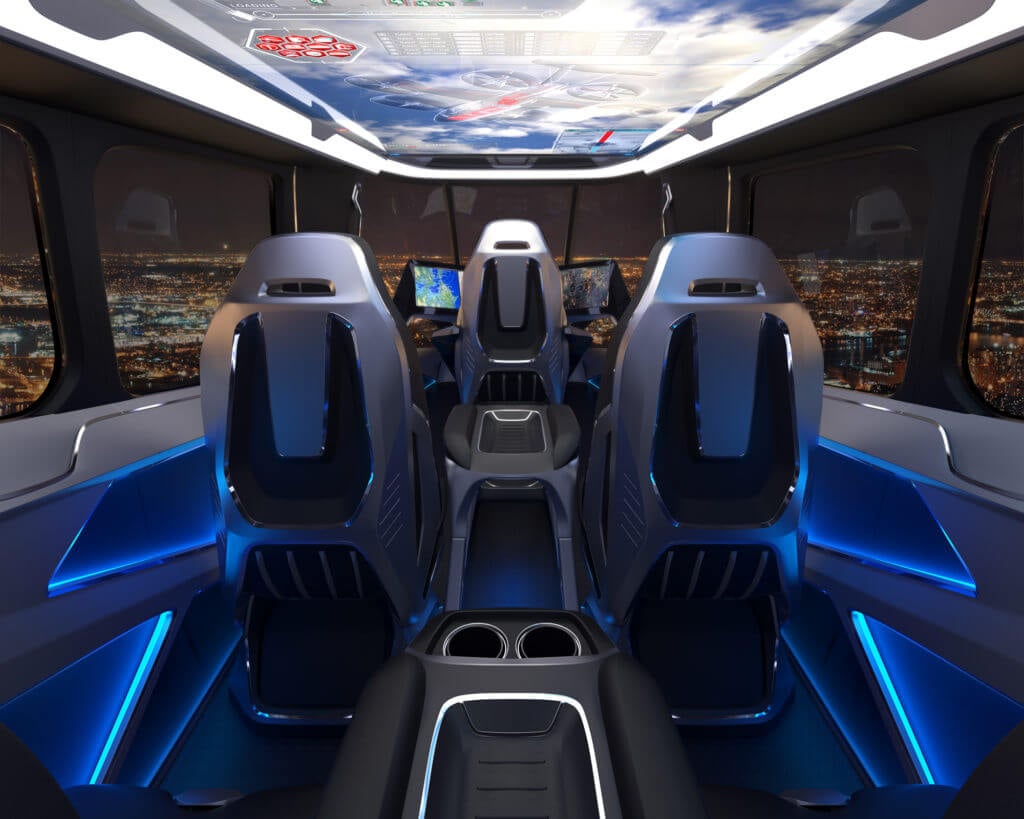
“That includes turbine engines, high power electrical machines, high voltage distribution, and then critically important, of course, is the integration and control of all that,” he said.
In July 2018, Safran completed its first ground test of a hybrid electric distributed propulsion system on purpose-built rig at its facility near Pau-Pyrenees Airport, in France. “This test marks a major step forward in demonstrating our ability to offer hybrid propulsive solutions for tomorrow’s aircraft,” said Jean-Baptiste Jarin, vice president of Safran Helicopter Engines’ hybrid propulsion system program, in a press release issued at the time.
The system on Safran’s test bench is “a very similar configuration” to that used in the Nexus, said Heironimus.
The battery in the Nexus, produced by Electrical Power Systems, is being built with lithium-ion based cells that are contained in a pack with a battery management system. This monitors the cells and can shut they pack down if they’re not operating safely, said Heironimus. The chemical composition of the cells may change by the time the aircraft enters the market in the mid-2020s, he added.
The Nexus is being designed as a piloted aircraft to begin with for greater customer acceptance, but Bell has complete autonomous flight in mind for the aircraft’s wide-scale operation. “We’ll need to transition into autonomous flight in order to make the business case [for the Nexus] really hum and make sense,” said Drennan.
Rethinking flight controls
Jeff Epp, the flight control systems lead for the Nexus, said the system is “different from anything in the past,” with a distributed flight control system with all-electric actuators — meaning no hydraulics.
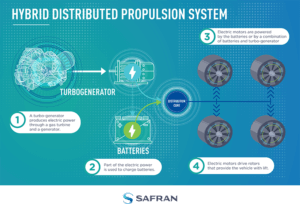
The fly-by-wire nature of the system allows the flexibility of piloted or autonomous operations, and provides the opportunity for “non-conventional” controls in the cockpit, said Epp. Bell is working with Thales’s flight controls systems group, which is based in Montreal, Quebec, on the controls for the Nexus, while Moog is a partner on the aircraft’s actuation systems.
The brains of the Nexus is the vehicle management computer (VMC), which can manage or control the aircraft’s systems. This is being developed in partnership with Garmin.
“The goal of the VMC is to be the ultimate pilot assistant, reducing pilot workload, enhancing situational awareness, and increasing safety,” said Frankie Mazzei, avionics lead for the Nexus. Bell wants the VMC to have communication and navigation functions, serve as a flight director for the flight control system, and have the capability to perform flight management — uploading and storing flight plans to use in the airspace in which it operates. Finally, it will interface with existing aircraft sensors and future sensored technology.
The exact nature of the pilot interface — the controls the pilot will use to actually fly the aircraft — is still being determined.
“Up until now, when we’ve built any kind of vehicle, we’ve always had a very known quantity of what the operator was going to be. Now, we don’t,” said Jim Gibson, an experimental test pilot at Bell. “The industry is advertising that air mobility is going to be for the masses, and certainly Bell hopes that it is for the masses, but the design challenge is we now have to design the controls and the aircraft for the masses.”
To help it do this, Bell is starting from scratch, looking at how a non-piloting member of the public would interact with flight controls. The company has created “Future Flight Controls” simulators to collect the data it needs from potential operators to understand what designs will be most intuitive to those who don’t have a background in aviation, but could potentially be flying air taxi aircraft like the Nexus.
It hopes the fixed-base simulators — which include both single and dual controls, as well as traditional helicopter controls — will show it what actions and interfaces will be easiest for non-pilots to use to control a vertical-lift aircraft. A brief survey completed by participants prior to each flight will show what (if any) prior experiences and abilities contributed to each participant’s actions.
The simulators will be taken to CES and Heli-Expo, as well as to other events, and Bell even plans to take them to schools and colleges to hit the future demographic of potential “pilots.”
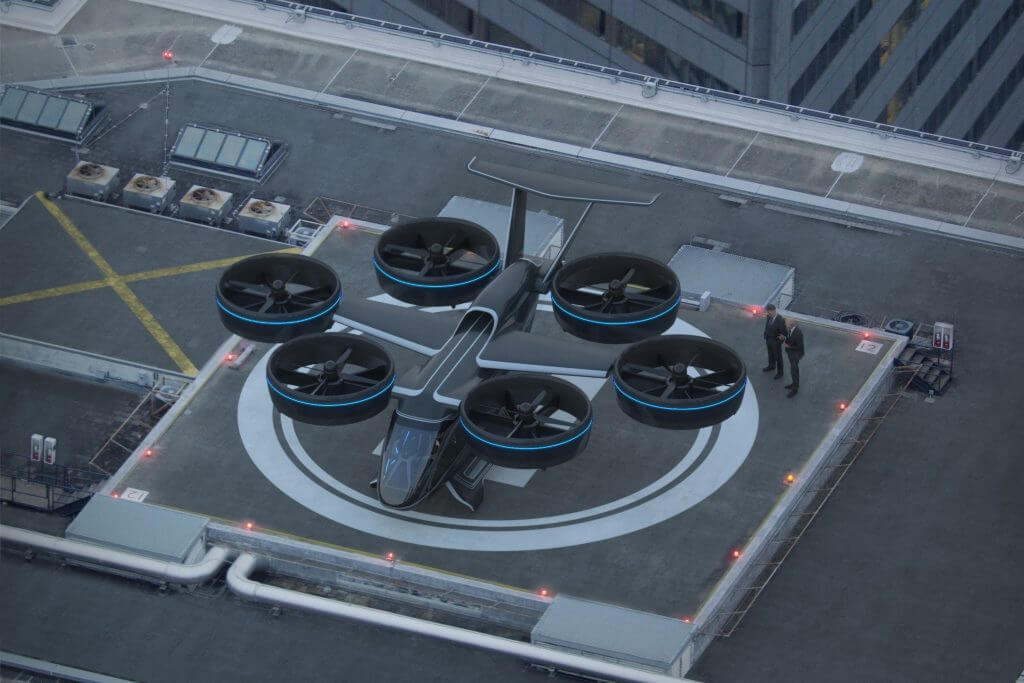
Building an eVTOL strategy
Bell’s eVTOL strategy is built around four integrated frameworks: operational, regulatory, manufacturing, and technology.
The company’s operational framework is helping it to define the requirements for an on-demand urban air mobility network — spanning community engagement, infrastructure development, safety and acoustic considerations, and the crucial need to develop an end product that’s actually affordable.
The regulatory piece of the puzzle involves ongoing discussions with the Federal Aviation Administration (FAA), the European Aviation Safety Agency (EASA), and other regulatory stakeholders to establish an integrated approach across vehicle, operational and air traffic requirements.
“We firmly believe that current aviation safety expectations should be met and even exceeded by these new vehicles [and] by their operational models, and the operational infrastructure itself must also mitigate risks along the way,” said Drennan. “A holistic regulatory approach will help provide clear passage to compliance and permission to operate for urban air mobility concepts.”
The manufacturing framework reflects the importance of having a “dependable and repeatable” fabrication and assembly process for Nexus.
“Quality and safety are baseline expectations for all of us, so the primary efforts here focus on cost, weight and environmental impact,” said Drennan.
Finally, the technology framework is informed by the needs created by the other three frameworks. Within it, Bell believes it is creating the foundation for “a new era of flight” through the technologies being developed by the company and its partners.
Drennan believes the development of the technology is perhaps the easiest aspect of bringing aircraft like the Nexus to market.
“It’s so easy for everybody to talk about the technology — it excites everybody and it’s kind of what the engineers on the team do anyway,” he said. “But we think the operational model, that first framework is going to be a challenge. How does the airspace get managed? How do the vehicles not only speak to each other, but the infrastructure they have to interact with, and then back to the main air traffic control system as well? So I think that’s going to be a pretty good challenge.”
The public will be able to see the Nexus at full scale at CES and then Helicopter Association International (HAI) Heli-Expo 2019 in Atlanta, Georgia, which runs from March 5 to 7.
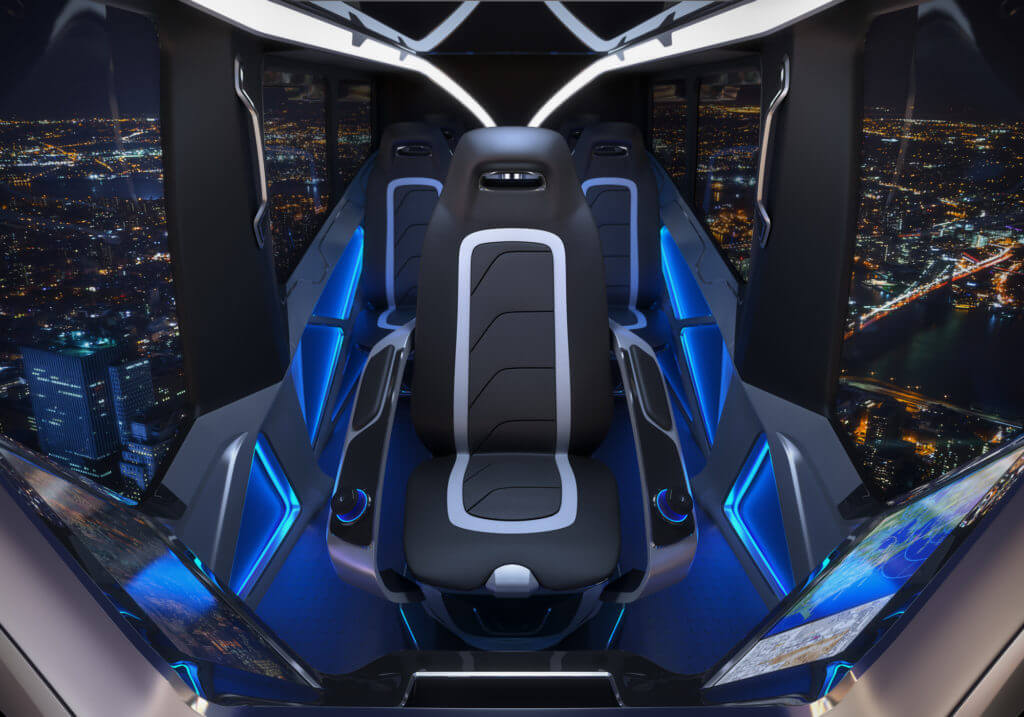
Bell brought a mockup of the Nexus’s fuselage to CES and Heli-Expo last year, with the former serving as an opportunity to introduce the concept of urban air mobility to a new set of customers. This year, the full-scale mockup (in a one-two-two passenger configuration) will be joined by the future flight controls simulators and the APT multicopter the company is developing.
“The challenges facing our population centers aren’t going away and won’t be solved through conventional means,” said Drennan. “There is still a lot of work to be done to create a viable urban air mobility network, but we believe the future is real, possible and coming to a city near you.”





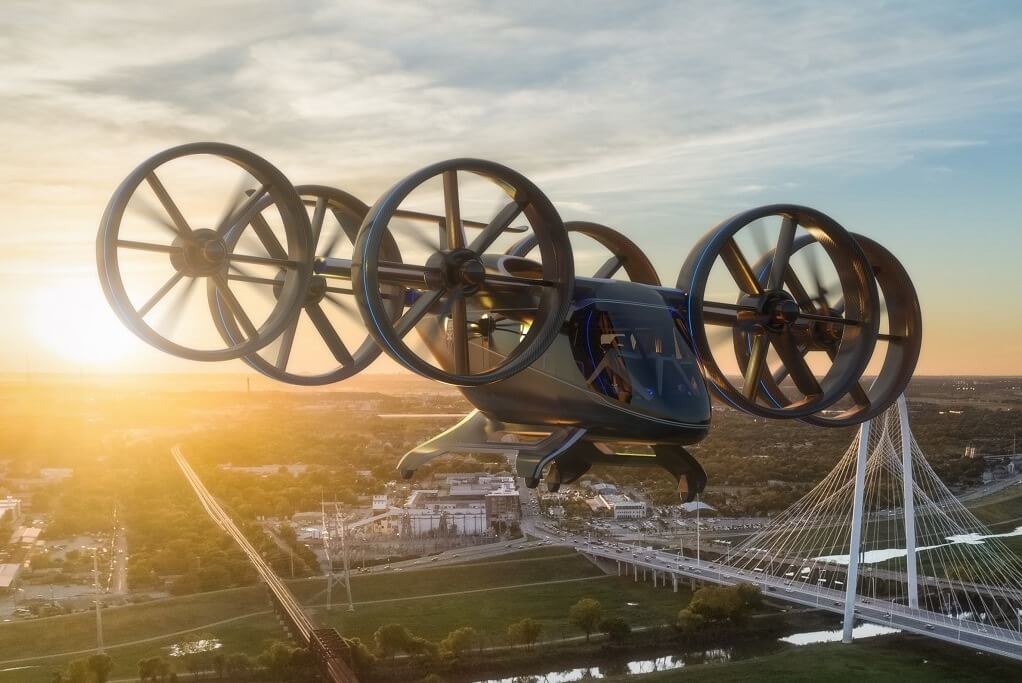




Truly a forward thinking design. Plus, I like using the turbine to power an electric generator. Batteries are just too heavy. Now let’s see “if” Bell can follow through.
With turbine to battery power and six lift fans this craft will be almost as loud as a helicopter. I can’t really see that being any more acceptable to noise conscious people than a current helicopter. Or even cheaper to run for that matter
@Andy, perhaps the hybrid design will allow battery-powered takeoff and landings. By restricting the turbine use to when the airship is underway, the noise would be less pervasive.
if we want lightness + silence + range then the only technology available today is fuel cell
“replacing the connecting shafts”
No, if a motor or controller fails you need linkage.
“land safely under its own power”
If the turbine fails you need 100 kWh pack with 1 megawatt discharge capability.